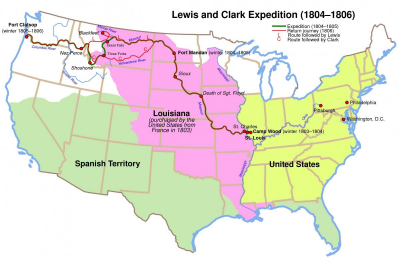The Great Falls of the Missouri River are a series of waterfalls on the upper Missouri River in north-central Montana in the United States. From upstream to downstream, the five falls along a 10-mile (16 km) segment of the river are:
Black Eagle Falls (26 feet 5 inches or 8.05 meters)
Colter Falls (6 feet 7 inches or 2.01 meters)
Rainbow Falls (44 feet 6 inches or 13.56 meters)
Crooked Falls, also known as Horseshoe Falls (19 feet or 5.79 m)
Big Falls, also known as the Great Falls, (87 feet or 26.52 m)The Missouri River drops a total of 612 feet (187 m) from the first of the falls to the last, which includes a combined 187 feet (57 m) of vertical plunges and 425 feet (130 m) of riverbed descent. The Great Falls have been described as "spectacular", one of the "scenic wonders of America", and "a major geographic discovery". When the Lewis and Clark Expedition became the first white men to see the falls in 1805, Meriwether Lewis said they were the grandest sight he had beheld thus far in the journey.The Great Falls of the Missouri River were depicted on the territorial seal of the Montana Territory, and later on the state seal of Montana in 1893.
The Lewis and Clark Expedition from August 31, 1803, to September 25, 1806, also known as the Corps of Discovery Expedition, was the United States expedition to cross the newly acquired western portion of the country after the Louisiana Purchase. The Corps of Discovery was a select group of U.S. Army and civilian volunteers under the command of Captain Meriwether Lewis and his close friend Second Lieutenant William Clark. The expedition made its way westward, and crossed the Continental Divide of the Americas before reaching the Pacific Coast.
President Thomas Jefferson commissioned the expedition shortly after the Louisiana Purchase in 1803 to explore and to map the newly acquired territory, to find a practical route across the western half of the continent, and to establish an American presence in this territory before European powers attempted to establish claims in the region. The campaign's secondary objectives were scientific and economic: to study the area's plants, animal life, and geography, and to establish trade with local Native American tribes. The expedition returned to St. Louis to report its findings to Jefferson, with maps, sketches, and journals in hand.

1805Jun, 13
Lewis and Clark Expedition: scouting ahead of the expedition, Meriwether Lewis and four companions sight the Great Falls of the Missouri River.
Choose Another Date
Events on 1805
- 7Apr
Symphony No. 3 (Beethoven)
German composer Ludwig van Beethoven premiered his Third Symphony, at the Theater an der Wien in Vienna. - 13Jun
Great Falls of the Missouri River
Lewis and Clark Expedition: scouting ahead of the expedition, Meriwether Lewis and four companions sight the Great Falls of the Missouri River. - 21Oct
Battle of Trafalgar
Napoleonic Wars: Battle of Trafalgar: A British fleet led by Vice Admiral Lord Nelson defeats a combined French and Spanish fleet under Admiral Villeneuve. - 11Nov
Battle of Dürenstein
Napoleonic Wars: Battle of Dürenstein: Eight thousand French troops attempt to slow the retreat of a vastly superior Russian and Austrian force. - 2Dec
Battle of Austerlitz
War of the Third Coalition: Battle of Austerlitz: French troops under Napoleon Bonaparte decisively defeat a joint Russo-Austrian force.

 English
English  español
español  français
français  português
português  русский
русский  العربية
العربية  简体中文
简体中文 